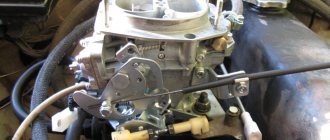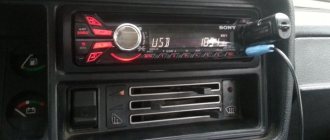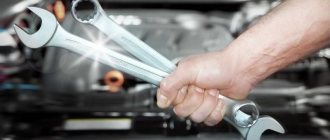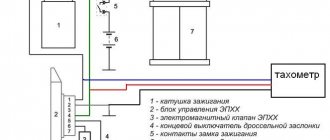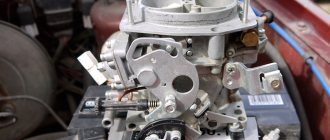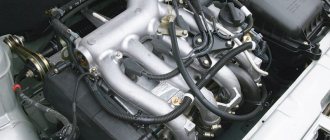Carburetor 2106
The standard option used on the Six engine is the “Ozone” sample. This is a two-chamber carburetor, with a falling air flow, emulsion type. The technical characteristics of the engine, when running, produced 75 horsepower, and the maximum speed was 155 km/h. Acceleration time to hundreds is 16 seconds.
The engine response is good, but when you press the gas pedal sharply, the car first chokes and then starts to move. This was explained by the fact that in the Ozone float chamber, the fuel level was insufficient, and during sharp acceleration there was not enough of it.
VAZ 2106 car owners were racking their brains over the question of which carburetor is better to install so that the engine's throttle response increases, while having minimal losses. Most opinions agreed that installing a Solex with a VAZ 21083 would be the best option.
How to adjust idle speed on a Solex carburetor
Just as in the case of “Ozone”, before adjusting the idle speed, the car’s internal combustion engine must be warmed up to operating condition, and both the engine itself and the spark plugs, fuel pump, high-voltage wires must be in good working order, and the air and fuel filters must not be dirty. The air damper should be opened all the way (recess the choke handle all the way), then proceed to adjust the XX using the quantity and quality screws:
- using a large screw (quantity), turning it in, we increase the speed;
- We tighten the quality screw until the engine starts to slow down and work intermittently, then we unscrew it until the engine starts to operate stable;
- Using both screws, we achieve the most optimal mode by setting the idle speed to 850-950 rpm.
After the adjustment operation, you should check the dynamics and stability of the engine while driving: the engine should not stall when the gas is suddenly released, and there should be no dips, jerks or jolts when driving.
Carburetor VAZ 21083
The VAZ 21083 car was equipped with a Solex carburetor. Just like Ozone, it was intended for 1500 cc engines. Its float (primary) and secondary chambers were slightly enlarged, and the fuel level was correspondingly higher. Solex provided the Eight with the following technical indicators: power - 70 hp, rated speed - 155 km/h. At the same time, acceleration to 100 km/h took 15 seconds.
The characteristics are not particularly better than those of the VAZ 2106. But this is explained by a different engine structure. And here’s what the “Six” will show us, when equipped with this carburetor.
Which carburetor model to choose
For any VAZ car, starting from 2101 to 2107, only certain carburetor models are suitable.
DAAZ carburetors
Carburetors DAAZ 2101, 2103, 2106. They were produced at the Dmitrov Automotive Unit Plant, which bought a license from the Italian company Weber, therefore these carburetors can be indicated under both names. The devices were not distinguished by the complexity of their design, but they could please their owners with the rapid acceleration of the car and good speed. One of the biggest problems in installing these models is their virtual absence on the market.
In addition to speed and simplicity, Weber carburetors also provided incredibly fast fuel consumption - these “monsters” consumed 10–14 liters per 100 km. fuel.
The powerful but resource-intensive Weber carburetor was produced by the Russian Dmitrov plant using Italian technology
Carburetors "Ozone"
More technologically advanced models, which were already installed in VAZ 2105 and 2107 cars, were also produced at the Dmitrov Automobile Unit Plant. However, they were not only more advanced and improved, but also more environmentally friendly. This is why they received the name “Ozone”. This carburetor made it possible to reduce fuel consumption to 7–10 liters. 100 km, while maintaining the dynamic characteristics of its predecessors. The downside of the device was the complexity of its assembly and constant contamination in one of the chambers, which led to the fact that the acceleration of the car noticeably deteriorated, the speed decreased and the engine began to act up.
“Ozone” is an environmentally friendly model of DAAZ carburetors
Solex
A little later, DAAZ 21053 carburetors appeared. They were produced under license from the French company Solex, hence the name of the models. These carburetors were not much similar to previous DAAZ models. The updated design with a fuel return system made it possible to save 400–500 ml of fuel per 100 km. These carburetors were distinguished by good power and low gasoline consumption. The disadvantage of the device was the narrow fuel and air channels, which very often became clogged.
The Solex carburetor successfully combines the power and environmental friendliness of its predecessors
Solex carburetors came in many variations with different auxiliary systems. In the CIS, the most popular option has become an electric idle air valve.
Custom carburetor Solex 21073
Often, inquisitive car enthusiasts resorted to replacing the carburetor on their own. One of the suitable models turned out to be Solex 21073, famous for its fairly wide jets and channels. Such a carburetor increased the car’s power, but at the same time increased fuel consumption - 9–12 liters. per 100 km.
Solex 21083
The second non-standard carburetor, which with some modifications fits the VAZ 2106 and 2107 models, is Solex 21083. After expanding the diffusers and installing jets, this device allows you to significantly increase the dynamics of the car without much fuel consumption. However, the process of upgrading a carburetor is very complex and time-consuming.
Installation procedure
The Solex carburetor is absolutely suitable for mounting on the VAZ 2106 engine. Since the device itself is different, you will need to purchase some additional parts in order for the installation to be successful and the engine to work properly. The parts list includes the following items:
- 2 paronite gaskets and 1 paper;
- 1 meter of hose for fuel supply;
- Carburetor, always with a slide;
- A set of keys, screwdrivers and other locksmith supplies.
Now, you can get to work. Before installing the Solex on a VAZ 2106, clean the area where the Ozone carburetor connects to the engine. This is done so that when removing, debris does not get into the engine. Next, disconnect all the hoses and cables.
Next, unscrew the fastenings and remove the “Ozone” from the engine. Before installing the carburetor from the VAZ 21083, clean the mounting location. Afterwards, apply sealant and lay the gasket. The gaskets should be in this order: thin, thick and thin.
When the seat is ready, disassemble the Solex into two parts. This will make it easier for you to install it. First of all, install the rocker from the carburetor VAZ 21083 to 2106, as this is the key element required to begin the installation. You can already install the Solex on it.
Now, connect all the cables and hoses. We start with the throttle cable. It must be set to the required length, which is enough to connect it. Next in line is the fuel system hose. Before installing it, it is worth considering that on the VAZ 21083 it is longer than on the 2106, so you will need a pre-prepared meter hose. Place one of its tips on the outlet of the fuel system, and the second on the inlet to the carburetor. Before putting on the second end, it is better to cut it so that it does not dangle freely in the engine compartment. Also, remember, the longer the hose, the more fuel it will contain, and therefore the weight. This can cause it to become disconnected and possibly even cause the engine to catch fire.
Connecting and setting up the rods
Next, we connect one end of the return flow to the fine filter, do not forget to install a valve in it. Place the other end on the carburetor. We put all the springs in their places (they do not need to be replaced with new ones). Once all the hoses and cables are in place, you will need to worry about the idle speed. To do this, install a solenoid valve.
The final touch is to put on the top part of the carburetor and tighten the fastening nuts. Now, your Solex is ready for use.
Settings
Before you start operating the carburetor from a VAZ 21083 on a VAZ 2106, it must be configured.
In order for the mixture to be prepared better and for you to make adjustments easier, park the car on level ground, without slopes. Start the engine and test it at high and low speeds. This will let you know in which mode the engine receives a normal mixture, and in which it requires adjustment.
After running the engine for a while on the new carburetor and filling its chambers with gasoline, you will need to check what a constant level is in them. To do this, remove the cover from the carburetor, and using a caliper, measure the distance from the fuel level to the top edge of the float chamber. It is best if the level is from 23 to 25 mm. In this case, the carburetor will not flood the spark plugs and stall at idle.
To adjust the fuel level, simply bend the float in the desired direction (up or down). After each change in position, check the resulting distance. When the float is set, assemble the device and begin adjusting the quality and quantity of fuel.
On a VAZ 21083, the correct mixture is obtained with the following settings:
- Quantity screw: 1.5 – 2 turns;
- Quality screw: 4 – 4.5 turns.
After installing it on the VAZ 2106, it is necessary to configure the device after the engine has run at all speeds. And also, the fuel must be heated to operating temperature.
After installation, the characteristics of the Six engine will acquire several pros and cons.
The advantages are that the engine will be more responsive, the maximum speed will increase (up to 160 -165 km/h), and the acceleration time to the first hundred will be reduced (instead of 15 seconds - 13). The modernization will not significantly affect the rated power, increasing it by 5 - 10 hp.
The only downside is fuel consumption. With normal, non-economical driving in the urban cycle, it will increase by 1 - 1.5 liters.
The general conclusion is this: installing this carburetor is a necessary thing, because for the price of 1 - 1.5 liters per 100 kilometers, you will get more driving comfort.
Bottom line
After installation, the characteristics of the Six engine will acquire several pros and cons.
The advantages are that the engine will be more responsive, the maximum speed will increase (up to 160 -165 km/h), and the acceleration time to the first hundred will be reduced (instead of 15 seconds - 13). The modernization will not significantly affect the rated power, increasing it by 5 - 10 hp.
The only downside is fuel consumption. With normal, non-economical driving in the urban cycle, it will increase by 1 - 1.5 liters.
The general conclusion is this: installing this carburetor is a necessary thing, because for the price of 1 - 1.5 liters per 100 kilometers, you will get more driving comfort.
What to put?
Sometimes there is a need to completely replace the carburetor. Therefore, you immediately need to decide which model to buy. Today there are two most common families: Solex and Ozone carburetors.
Many car owners don’t even know what kind of device they have. Externally, these devices can be distinguished by the following characteristics.
- In Ozone, the fuel intake fitting has the shape of an oblong tube, in Solex it is a return
- Ozone consists of three parts: the throttle valve axis, the float chamber and the cover. Solex consists of only two parts: the lower part with the float chamber and the upper part - the cover in which the float is held.
- The ozone has a vacuum valve that controls the opening of the throttle valve of the second chamber.
- On a Solex carburetor, the air damper is controlled by such a large lever: On ozone, this lever looks completely different. It is also called a three-arm lever.
In the 90s, a massive hobby began to replace the standard Ozone with Solex. Taxi drivers were especially guilty of this. This was explained by the fact that fuel consumption decreased slightly, and engine dynamics became a little better.
If you install an oxygen sensor and compare its values on different models, you can understand the reason for this phenomenon. With Solex, after adjusting the mixture composition, the range in composition is no more than one. On ozone, after adjusting the mixture at the moments of braking and acceleration, the mixture acquires a very strong spread of values. At the same time, it can increase or decrease by a large value.
This is due to the fact that the jets on the Solex are located in the center of the float chamber. When the position of the car changes during sharp turns or during acceleration and braking, part of the fuel is deflected by inertia towards one of the walls of the float chamber. The central location of the jets reduces the likelihood of changes in the fuel composition at these moments.
On ozone, the device is significantly different. The jets are not in the center. Therefore, fuel moves around the float chamber in different directions, which significantly changes the spread of air proportions in the fuel mixture. In different driving modes, the engine receives a different mixture composition.
So, the Solex carburetor on the VAZ 2106 keeps the mixture more stable while driving. This is its main technical advantage.
How to choose jets for Solex?
With proper selection of jets for the Solex carburetor, the engine will operate smoothly and stably even under frequent loads. At the same time, you will also be able to save up to 35% of gasoline in city mode. First of all, you should decide on the main element, and then you can move on to the air element. Moreover, engine size is of great importance when selecting. If it is large, then it is better to use secondary jets of small cross-section. The diameter of parts with calibration holes in the first and second chambers may differ slightly.
You can easily find special tables that indicate the optimal ratio of fuel and air jet indices for Solex, and also predict the resulting mixture and even the behavior of the car. For example, if you take a fuel cell of high productivity, and an air cell, on the contrary, of low efficiency, then there will be an over-enriched mixture that will not ignite. A table will help you in the selection, which indicates the optimal diameter of all jets depending on the type of engine and brand of carburetor.
Jet index ratio table
It is very important to decide on the type and size of jets for Solex, but you also need to buy them. At this stage, you need to know what information is hidden by the numbers printed on the top of the elements. It is not uncommon when two designations are applied to the surface of a part, and a certain parameter is hidden in each of them. For example, the numbers “21” and “23” correspond to the outer diameter of the dosing element. By seeing the designation “95” or “97.5” on the main fuel jets, you can judge the performance, since this designation characterizes the throughput of the element. Air elements also indicate their capacity, but this value is usually between “125” and “155”.
Some people are sure that there is no need to rush to select new jets, and you can increase the throughput of a part by boring out its diameter. However, this operation should be performed only on high-precision equipment. In garage conditions, you cannot change the diameter of the jets using a drill or drill, as this will only ruin them. Therefore, if a part does not fit according to some criteria, you should purchase a new element that meets the requirements.
Removing and installing the carburetor
- We remove the hose that takes warm air from the pipe. To do this, you will need to first loosen the clamp.
- Remove the air filter.
- Cover the carburetor with a clean, lint-free cloth. This is necessary so as not to accidentally drop the filter housing mounting nuts into the float chamber.
- Unscrew these nuts.
- We remove the plate.
- Remove the hose from the crankcase.
- Remove the filter housing.
- Remove the fuel hose.
- Remove the tip of the solenoid valve.
- Unscrew the bolt that secures the drive cable.
- Unscrew the cable screw.
- Carefully remove the cable.
- Remove the gas exhaust hose from the crankcase.
- Removing the ignition regulator hose
- We remove the spring.
- Unscrew the nuts securing the carburetor. You need to act very carefully, not to use too much force. The fact is that the mating plane of the device is made of soft metal and can easily be damaged.
- The carburetor can be removed from the engine.
Installation of a working device is carried out in reverse order according to the same scheme.
This article is part of a series of 9 lessons dedicated to 7 carburetors. To view all nine lessons, follow the link: https://7vaz.ru/chto-takoe/karbyurator.html
Source: 7vaz.ru
Setting the gasoline level in the float chamber
To adjust the float in the DAAZ carburetor, the entire assembly itself does not need to be removed, but partial disassembly is necessary. To carry out adjustment work, perform the following steps:
- turn off the engine, open the hood;
- dismantle the air filter cover (unscrew three nuts);
- remove the filter housing itself (four more nuts);
- disconnect the choke cable;
- remove the telescopic rod of the starting device;
- unscrew the five screws securing the carburetor cover (they need to be carefully removed and reassembled, it is important not to drop the fasteners into the manifold);
- for ease of operation, disconnect the fuel supply hose;
- turn the lid over and determine the gap between the float and the cardboard spacer, it should be within 6-6.5 mm;
- if the gap differs from the required value, we make the adjustment by bending the tongue;
- It will also be necessary to align the float itself on a plane; it may be beveled relative to the surface of the cover.
When adjusted correctly, immediately after removing the cap, the gasoline in the float chamber is approximately at the level of the middle of the beveled surface of the carburetor body, and the float stroke is about 14 mm.
Modernization of the VAZ-2106 car: installation and adjustment of the Solex carburetor
Initially, the VAZ-2106 car left the factory with an Ozone carburetor. However, this unit has so many shortcomings that with the advent of the more modern Solex carburetor, many owners of classic Zhiguli cars could not resist the opportunity to improve the engine of their car. Among most of them there was an opinion that this would improve the technical characteristics of the car, while others believed that this decision would have a detrimental effect on the stability of the engine. In this article we will look at what advantages such a modernization has and, if any, how to install and adjust the Solex carburetor on a VAZ-2106 car with your own hands.
With the “native” carburetor, the engine of the “sixth” model had good throttle response. But there was also a significant drawback in the form of failures when trying to sharply increase the crankshaft speed. That is, as soon as the driver pressed the gas pedal, the engine first “choked” and only then began to gain momentum. The reason for this is the insufficient fuel level in the float chamber, which affected during intensive acceleration of the car. That is why the owners of the “sixes” wondered about the possibility of installing an alternative carburetor that could increase the engine’s throttle response with minimal losses. The choice fell on the Solex unit as the best option.
Initially, the six was equipped with an OZONE carburetor
Do-it-yourself Ozone carburetor adjustment
The name “Ozone” came into use with the start of production of the VAZ-2105 car; it was for this model that the Dmitrovgrad Automotive Aggregate Plant (DAAZ) developed a new carburetor for an engine with a capacity of 1300 cubic centimeters. For the Zhiguli “Seven”, DAAZ-2107 carburetor units began to be produced, working with 1.5 liter engines, and they were also installed on the VAZ “Six”.
If the car consumes fuel within normal limits, accelerates normally and does not jerk when driving, it is not recommended to make any additional adjustments with your own hands, especially if the driver does not have sufficient experience in this matter. Adjustment is necessary in cases where:
- increased fuel consumption;
- the engine runs unsteadily (jerks) at idle;
- the engine gains momentum with dips;
- The engine stalls at minimum speed.
Also, the internal combustion engine can malfunction if the fuel supply is poor, and it is difficult to start in cold weather due to an unconfigured starting device.
It is generally accepted that a car owner or any person who is an amateur in the automotive business is able to independently perform the following types of work:
- adjust the position of the float in the float chamber;
- configure the launch system;
- adjust the idle speed;
- Replace the strainer located in the carburetor cover.
The most common and popular procedure is debugging the idle speed; both fuel consumption and engine response largely depend on it.
Installing a Solex carburetor on a VAZ six
Since the unit from the VAZ-21083 car was intended for an engine with the same volume (1500 cm 3), it was the one that was best suited as an alternative to the standard Ozone. Thanks to enlarged float chambers, a higher level of gasoline was provided. Paired with the V8 engine, it demonstrated not particularly outstanding characteristics compared to the VAZ-2106. However, he still managed to improve the model. Next, we will look at how to correctly install a Solex carburetor on a VAZ-2106, after which we will figure out how to adjust it.
The carburetor in question is not so difficult to install on a “six” engine, since its mountings are exactly the same as those of the original unit. However, its design itself is different, so you will have to purchase some parts before installation. For successful installation and normal operation of the engine, in addition to the carburetor itself, you will need:
- a set of gaskets - one paper and two paronite;
- fuel hose 1 meter long;
- standard set of wrenches and screwdrivers;
- sealant (can be purchased at any auto parts store).
Experienced motorists often replace problematic Ozone with the more reliable Solex
If you have prepared everything you need, you can begin installation, but before installing the Solex carburetor, make sure that there is no dirt or dust where it contacts the intake manifold. It is assumed that you have previously removed the old unit by unscrewing the fastening nuts and disconnecting all rods, wires and hoses. Clean the connection area thoroughly to prevent foreign objects from entering the motor and follow the instructions below:
- Apply a sealing compound to the contact area of the surfaces and place three gaskets so that one thick one is between two thin ones. After preparing the seat, you can begin installing the Solex carburetor on the VAZ-2106 engine, but before that it is better to disassemble it into two parts, which will significantly simplify the installation process.
- Now you can install the linkage of the throttle drive rods from the VAZ-21083, after which all that remains is to place the unit itself in its place, securing it with fastening nuts.
- Further steps involve connecting the cable and hoses. And you should start with the cable that controls the air damper. It must be set to a length sufficient for connection.
- After this, the turn comes to the fuel hose, which should be connected at one end to the fuel system, and the other end should be put on the carburetor inlet. It is better to adjust the length of the hose in advance so that it does not dangle in the engine compartment.
- As for the return fuel line, it must be connected to the fine filter through a check valve - this way it will be involved in the fuel supply circuit. There is another option that involves installing a simple plug in the fuel return fitting. But the first method is more preferable, since it eliminates the possibility of overloading the carburetor valve mechanism, which can cause problems in its operation.
- If the return issue is resolved, all that remains is to install the solenoid shut-off valve. After this, replace the top of the carburetor with a new gasket and secure it with nuts.
- The hoses of the vacuum regulator and heating system should be connected to the tee of the unit. After this, replace all the springs; they do not need to be replaced if they are in good condition. Reinstall the air filter housing and cover.
How to adjust a Solex carburetor
Only a properly adjusted carburetor can ensure maximum engine performance and efficiency. For the most accurate adjustment, experts recommend installing the car on a level surface - this promotes better preparation of the air-fuel mixture. First, start the engine and test its operation at different speeds. This way, you can determine in which mode the normal mixture is prepared, and in which adjustment is required.
The following guide will tell you how to set up a Solex carburetor on a VAZ-2106:
- Once you have started the engine, let it run to warm up to operating temperature.
- During warm-up, the float chambers will fill with fuel, which will allow you to check its level. To do this, you need to remove the cover from the carburetor and measure the distance between the upper edge of the float chamber and the level of gasoline in it. Use a caliper. The recommended level at which the spark plugs will not flood and the engine will not stall at idle is 23–25 mm. If the obtained values do not correspond to the norm, you will have to adjust the carburetor regarding the fuel level.
- Adjustment of the gasoline level in the float chambers is carried out by bending/bending the float up or down.
- Once the setup and control measurements are complete, replace the cover and proceed to the next step.
- Next, adjusting the Solex carburetor on the VAZ-2106 consists of adjusting the idle system. If you purchased a new unit for installation, then the optimal settings for preparing a combustible mixture at idle speed are as follows:
- The mixture quantity screw must be unscrewed 1.5–2 turns;
- The mixture quality screw should be unscrewed 4–4.5 turns.
This concludes the guide on how to adjust the Solex carburetor on a VAZ-2106 after installing it. However, in conclusion, it should be said that the “sixth” model with this unit will inherit both important advantages and noticeable disadvantages. The first includes improved engine response and a top speed increased to 165 km/h. The modernization also has a positive effect on acceleration - the car will be able to reach the first 100 km/h two seconds faster. As for the disadvantages, there are only two of them - increased fuel consumption and increased requirements for the quality of gasoline use. In general, by installing a Solex carburetor on a VAZ-2106 with your own hands, you will get more comfortable driving, the cost of which is not so high.
Source: carextra.ru
Signs of a carburetor malfunction
As you use a car with a carburetor, certain problems may arise that require cleaning, adjusting the unit, or replacing any of its parts. Let's look at the most common problems with the mechanism and methods for eliminating them.
Stalls at idle
One of the most common malfunctions of carburetors of the VAZ 2106 and other “classics” is problems with idle speed. In this situation, the following happens: when you press the gas pedal, the engine normally picks up speed, and when you release it, the engine stalls, i.e., when the transition to idle mode (idle) occurs. There may be several reasons for this phenomenon:
- clogged jets and channels of the XX system;
- solenoid valve malfunction;
- problems with the forced stroke economizer;
- failure of the quality screw seal;
- the need to adjust the unit.
One of the common causes of a stalled engine at idle is clogged carburetor jets.
The design of the carburetor is made with a combination of the XX system and the primary chamber. As a result, problems may occur that lead not only to failures, but also to a complete stop of the motor. The solution to these problems is quite simple: replacing faulty elements, if necessary, cleaning and blowing the channels with compressed air.
Dips during acceleration
When accelerating a car, dips may appear, which represent a drop in acceleration or a complete stop of the car.
Dips can vary in duration - from 2 to 10 seconds; jerking, twitching, and swaying are also possible.
The main cause of this problem is a lean or rich fuel mixture entering the cylinders of the power unit when the gas pedal is pressed.
First of all, it is worth noting that failures can be caused not only by carburetor problems, but also by clogging or malfunction of the fuel system, as well as the ignition system. Therefore, you first need to check them and only after that start repairing the carburetor. The most likely cause of VAZ 2106 failures may be a clogged hole in the main fuel jet (GFJ). When the engine operates under low loads or in idle mode, a small amount of fuel is consumed. When you press the gas pedal, high loads occur, resulting in a sharp increase in fuel consumption. If the GTZ is clogged, the passage hole will become smaller, which will lead to a lack of fuel and failures in engine operation. In this case, the nozzle must be cleaned.
The appearance of dips can also be caused by clogged fuel filters or loose fuel pump valves. If there is an air leak in the power system, then the problem in question is also quite likely. If the filters become clogged, they can simply be replaced or cleaned (the mesh at the inlet to the carburetor). If the problem is caused by the fuel pump, the mechanism will need to be repaired or replaced with a new one.
One of the reasons for failures when pressing the gas pedal is a clogged fuel filter.
As for air leaks, this usually happens through the intake manifold. It is necessary to check the tightness of the connection between the carburetor and the manifold. To do this, with the engine running, spray WD-40 on the connections between the manifold, gaskets and carburetor on all sides. If the fluid leaves too quickly, it means there is a leak in that place. Next, you need to remove the carburetor and eliminate the malfunction (align it under a press or resort to improvised means).
Video: eliminating air leaks
Pouring candles
The problem with flooded spark plugs is familiar to almost every owner of a car with a carburetor engine. In this situation, starting the unit is quite difficult. When you turn the spark plug out, you can see that the part is wet, that is, it is filled with fuel. This indicates that the carburetor supplies a rich fuel mixture at the time of start-up. In such a situation, it is impossible for a normal spark to appear.
The problem with flooded spark plugs can occur both during a cold and hot start of the engine.
There are many reasons that lead to flooded spark plugs, but they all prevent normal spark formation
Since there may be several reasons for this phenomenon, it is worth considering them in more detail:
- Starting the engine with the choke pulled out. If you close the air damper on a warm engine, an over-enriched mixture will be supplied to the cylinders, which will lead to flooding of the spark plugs.
- The starter is faulty or needs adjustment. The problem in this case usually manifests itself when it is cold. In order for the starting device to be properly adjusted, the starting gaps must be set properly. The trigger device itself must have a complete diaphragm and a sealed housing. Otherwise, when starting a cold unit, the air damper will not open slightly to the required angle, thereby depleting the fuel mixture by mixing in air. If there is no such opening, the mixture will become enriched when starting cold. As a result, the candles will be wet.
- Faulty spark plugs. If the spark plug has black soot, an incorrectly set gap between the electrodes, or is completely broken, then the part will not be able to ignite the fuel-air mixture and will be flooded with gasoline when the engine starts. This indicates the need to have a set of spark plugs in stock so that replacement can be carried out if necessary. With such a malfunction, the part will be wet both cold and hot.
- Needle valve malfunction. If the carburetor needle valve in the float chamber has lost its tightness and allows more fuel to pass through than it should, the fuel mixture becomes rich during start-up mode. If this part fails, the problem can occur during cold and hot starts. Valve leakage can often be determined by the smell of gasoline in the engine compartment, as well as by fuel leaks on the carburetor. In this case, the needle must be checked and, if necessary, replaced.
- The fuel pump is overfilling. If the fuel pump drive is not adjusted correctly, the pump itself may pump fuel. As a result, excess gasoline pressure is created on the needle valve, which leads to an increase in fuel in the float chamber and an enrichment of the fuel mixture. To fix the problem, you need to adjust the drive.
- Clogged air jets of the main dosing system (GDS). GDS air jets are necessary to supply air to the fuel mixture so that it has the necessary proportions of gasoline and air for normal engine starting. Lack of air or its complete absence due to clogged nozzles leads to the preparation of an enriched combustible mixture and flooding of the candles.
Smell of gasoline in the cabin
Owners of the VAZ 2106 and other “classics” sometimes encounter such a nuisance as the appearance of the smell of gasoline in the cabin. The situation requires urgent search and elimination of the problem, since fuel vapors are harmful to human health and are explosive. There may be several reasons for this smell. One of them is damage to the fuel tank, for example due to a crack. Therefore, the container must be checked for leaks and, if a damaged area is detected, repairs must be made.
Due to incorrect adjustment of the fuel pump rod, fuel may overflow and the smell of gasoline may appear in the cabin.
The smell of gasoline can also be caused by fuel leaking from the fuel line (hoses, tubes), which could simply become unusable over time. Attention should also be paid to the fuel pump: if the membrane is damaged, gasoline may leak and smell may enter the cabin. Over time, the fuel pump rod wears out, which requires adjustment work. If the procedure is performed incorrectly, fuel will overflow and an unpleasant odor will appear in the cabin.
Stalls when you press the gas
There are many reasons why the engine stalls when you press the gas pedal. These could be:
- clogged accelerator pump nozzles;
- incorrect adjustment of XX;
- blockage of the transition system.
In addition, the reason may be in the distributor itself, for example, due to poor contact. As for the carburetor, you need to clean and blow out all the holes in it, check the jet markings with the table for a specific modification and, if necessary, install the appropriate part. Then the ignition is adjusted, having previously set the gap on the distributor cams, and the carburetor is also adjusted (fuel quality and quantity).
Video: fixing the stalling engine problem
Features of Solex carburetors
When installing Solex on a VAZ 2106, the power parameters of the power plant increase, the acceleration period of the vehicle becomes smoother. At the same time, when completing Solex 21083, the requirements for the quality composition of the fuel increase, which requires more frequent changes of filter elements. At the same time, automotive experts advise using filter elements for injection engine systems in the “six” cleaning system. With the use of these innovations, the frequency of replacement of replaceable components is reduced.
If you are installing a Solex carburetor on a VAZ 2106 that was previously used, then you should completely clean the product, polish the diffusers and purge the lines. It is also necessary to replace the jets, diaphragm plate and product gasket. When polishing diffusers, it is important to remove various burrs and irregularities and subject them to grinding. If such defects are not eliminated, the completeness of filling the power plant cylinders with the fuel-air mixture decreases and vortex aerosol flows are formed, reducing the dynamics of the engine.
Replacing the Solex 21083 carburetor on a VAZ 2106
To carry out work on replacing the Solex 21083 carburetor, you need to prepare gasket material made of paronite, a fuel supply hose about 80 cm in length, a carburetor rocker and the Solex product itself. A set of motorist's locksmith supplies will be useful for the job.
Installing a Solex 21083 carburetor on a VAZ 2106:
- We clean the power compartment to prevent contamination of the motor and power system.
- We disconnect the cables and ties of the carburetor device, the fastenings of the fuel wires and hoses of the heating complex.
- We remove the bracket holding the casing covering the throttle valve drive cable.
- We clean the manifold platform for attaching the carburetor.
- Apply a layer of sealing lubricant to prevent air from entering the system.
- We place the gaskets in the following sequence: thin, then thick, then again thin gasket. A large cross-section gasket is used to remove heat and prevent heat transfer to the carburetor device.
- We mount the Solex on the seat, removing the front part of the product for ease of operation.
- We install the rocker on the side of the over-valve cylinder head cover.
- We pull the cable from the throttle drive of the carburetor valve and set the required length of the cable and then connect it to the carburetor device.
- We install the updated gasket and lock the front carburetor cover.
- We connect the hoses of the heating and distribution ignition system.
- Connect the tee to the fine fuel filter element and connect the return hose to the fuel system.
- We connect the reverse valve to the “return” hose, and then connect it to the carburetor device.
- We connect the return type spring to the axial element of the rocker, which is located on the cylinder head casing.
- We mount an additional spring element for the throttle drive of the carburetor valve for the period of running-in of the product (if necessary).
- Connect the idle air solenoid valve to the relay connector.
- Restore the original position of the air filter housing and connect the gas outlet hose.
- This completes the Solex installation.
Preparing for work to replace the carburetor
It won’t be possible to simply swap the power supply units of the internal combustion engine, since the VAZ 2107 has a different control system and it is impossible to install a Solex carburetor from the VAZ 2108 model without modifications. If you already have a carb from the “eight”, then you need to purchase a Solex installation kit for the “classic”.
It consists of the following elements:
- choke cable from 2108-09;
- two thin gaskets for the carburetor (paper/paronite);
- one thick gasket for the carb from getinax;
- tee for gas hose;
- fuel hose 80-90 cm;
- check valve 2108;
- accelerator link with throttle rods 2108-09;
- clamps for the fuel hose 6-8 pcs.
To dismantle and subsequently install the power supply, you will need a tool. It includes: pliers, open-end wrenches 7, 8, 10, 13 mm. Screwdrivers: slotted and Phillips.
For reference! If the car is equipped with an old type distributor, then a contactless ignition should be installed on the vehicle. The fact is that Solex 21083 is designed for operation on a lean mixture. To ignite it, you will need an enhanced charge, which an ignition coil with a power of 25-30 kW can produce. An additional condition is to unscrew the spark plugs and set the gap on the electrodes to 07 - 0.8 mm.


